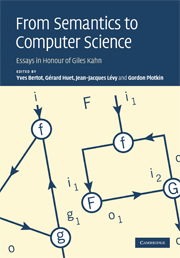Book contents
- Frontmatter
- Contents
- List of contributors
- Preface
- 1 Determinacy in a synchronous π-calculus
- 2 Classical coordination mechanisms in the chemical model
- 3 Sequential algorithms as bistable maps
- 4 The semantics of dataflow with firing
- 5 Kahn networks at the dawn of functional programming
- 6 A simple type-theoretic language: Mini-TT
- 7 Program semantics and infinite regular terms
- 8 Algorithms for equivalence and reduction to minimal form for a class of simple recursive equations
- 9 Generalized finite developments
- 10 Semantics of program representation graphs
- 11 From Centaur to the Meta-Environment: a tribute to a great meta-technologist
- 12 Towards a theory of document structure
- 13 Grammars as software libraries
- 14 The Leordo computation system
- 15 Theorem-proving support in programming language semantics
- 16 Nominal verification of algorithm W
- 17 A constructive denotational semantics for Kahn networks in Coq
- 18 Asclepios: a research project team at INRIA for the analysis and simulation of biomedical images
- 19 Proxy caching in split TCP: dynamics, stability and tail asymptotics
- 20 Two-by-two static, evolutionary, and dynamic games
- 21 Reversal strategies for adjoint algorithms
- 22 Reflections on INRIA and the role of Gilles Kahn
- 23 Can a systems biologist fix a Tamagotchi?
- 24 Computational science: a new frontier for computing
- 25 The descendants of Centaur: a personal view on Gilles Kahn's work
- 26 The tower of informatic models
- References
18 - Asclepios: a research project team at INRIA for the analysis and simulation of biomedical images
Published online by Cambridge University Press: 06 August 2010
- Frontmatter
- Contents
- List of contributors
- Preface
- 1 Determinacy in a synchronous π-calculus
- 2 Classical coordination mechanisms in the chemical model
- 3 Sequential algorithms as bistable maps
- 4 The semantics of dataflow with firing
- 5 Kahn networks at the dawn of functional programming
- 6 A simple type-theoretic language: Mini-TT
- 7 Program semantics and infinite regular terms
- 8 Algorithms for equivalence and reduction to minimal form for a class of simple recursive equations
- 9 Generalized finite developments
- 10 Semantics of program representation graphs
- 11 From Centaur to the Meta-Environment: a tribute to a great meta-technologist
- 12 Towards a theory of document structure
- 13 Grammars as software libraries
- 14 The Leordo computation system
- 15 Theorem-proving support in programming language semantics
- 16 Nominal verification of algorithm W
- 17 A constructive denotational semantics for Kahn networks in Coq
- 18 Asclepios: a research project team at INRIA for the analysis and simulation of biomedical images
- 19 Proxy caching in split TCP: dynamics, stability and tail asymptotics
- 20 Two-by-two static, evolutionary, and dynamic games
- 21 Reversal strategies for adjoint algorithms
- 22 Reflections on INRIA and the role of Gilles Kahn
- 23 Can a systems biologist fix a Tamagotchi?
- 24 Computational science: a new frontier for computing
- 25 The descendants of Centaur: a personal view on Gilles Kahn's work
- 26 The tower of informatic models
- References
Summary
Abstract
Asclepios is the name of a research project team officially launched on November 1st, 2005 at INRIA Sophia-Antipolis, to study the Analysis and Simulation of Biological and Medical Images. This research project team follows a previous one, called Epidaure, initially dedicated to Medical Imaging and Robotics research. These two project teams were strongly supported by Gilles Kahn, who used to have regular scientific interactions with their members. More generally, Gilles Kahn had a unique vision of the growing importance of the interaction of the Information Technologies and Sciences with the Biological and Medical world. He was one of the originators of the creation of a specific BIO theme among the main INRIA research directions, which now regroups 16 different research teams including Asclepios, whose research objectives are described and illustrated in this article.
Introduction
The revolution of biomedical images and quantitative medicine
There is an irreversible evolution of medical practice toward more quantitative and personalized decision processes for prevention, diagnosis and therapy. This evolution is supported by a continually increasing number of biomedical devices providing in vivo measurements of structures and processes inside the human body, at scales varying from the organ to the cellular and even molecular level. Among all these measurements, biomedical images of various forms increasingly play a central role.
Facing the need for more quantitative and personalized medicine based on larger and more complex sets of measurements, there is a crucial need for developing: (1) advanced image analysis tools capable of extracting the pertinent information from biomedical images and signals; (2) advanced models of the human body to correctly interpret this information; (3) large distributed databases to calibrate and validate these models.
- Type
- Chapter
- Information
- From Semantics to Computer ScienceEssays in Honour of Gilles Kahn, pp. 415 - 436Publisher: Cambridge University PressPrint publication year: 2009
References
- 1
- Cited by

